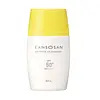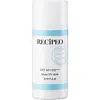What's inside
What's inside
 Key Ingredients
Key Ingredients

 Benefits
Benefits

 Concerns
Concerns

 Ingredients Side-by-side
Ingredients Side-by-side

Water
Skin ConditioningHomosalate
Skin ConditioningGlycerin
HumectantOctocrylene
UV AbsorberEthylhexyl Salicylate
UV AbsorberPentylene Glycol
Skin ConditioningButyl Methoxydibenzoylmethane
UV AbsorberButylene Glycol
HumectantIsostearic Acid
CleansingPCA
HumectantSodium PCA
HumectantAspartic Acid
MaskingAlanine
MaskingArginine
MaskingIsoleucine
Skin ConditioningGlycine
BufferingGlucosylrutin
AntioxidantGlutamic Acid
HumectantTremella Fuciformis Polysaccharide
Emulsion StabilisingAphanothece Sacrum Polysaccharide
AbsorbentCeramide Ag
HumectantCeramide AP
Skin ConditioningCeramide EOP
Skin ConditioningCeramide Ng
Skin ConditioningCeramide NP
Skin ConditioningSerine
MaskingTocopherol
AntioxidantThreonine
Niacinamide
SmoothingValine
MaskingPhytosterols
Skin ConditioningPhenylalanine
MaskingProline
Skin ConditioningBetaine
HumectantMacadamia Ternifolia Seed Oil
EmollientLysine Hcl
Skin ConditioningHydrolyzed Hyaluronic Acid
HumectantSodium Lactate
BufferingAcrylates/C10-30 Alkyl Acrylate Crosspolymer
Emulsion StabilisingXanthan Gum
EmulsifyingHistidine
HumectantPetrolatum
EmollientPotassium Hydroxide
BufferingHydrogenated Lecithin
EmulsifyingPhenoxyethanol
PreservativeWater, Homosalate, Glycerin, Octocrylene, Ethylhexyl Salicylate, Pentylene Glycol, Butyl Methoxydibenzoylmethane, Butylene Glycol, Isostearic Acid, PCA, Sodium PCA, Aspartic Acid, Alanine, Arginine, Isoleucine, Glycine, Glucosylrutin, Glutamic Acid, Tremella Fuciformis Polysaccharide, Aphanothece Sacrum Polysaccharide, Ceramide Ag, Ceramide AP, Ceramide EOP, Ceramide Ng, Ceramide NP, Serine, Tocopherol, Threonine, Niacinamide, Valine, Phytosterols, Phenylalanine, Proline, Betaine, Macadamia Ternifolia Seed Oil, Lysine Hcl, Hydrolyzed Hyaluronic Acid, Sodium Lactate, Acrylates/C10-30 Alkyl Acrylate Crosspolymer, Xanthan Gum, Histidine, Petrolatum, Potassium Hydroxide, Hydrogenated Lecithin, Phenoxyethanol
Zinc Oxide
Cosmetic ColorantCyclomethicone
EmollientCetyl Ethylhexanoate
EmollientWater
Skin ConditioningHydrogenated Polydecene
EmollientDimethicone
EmollientTriethylhexanoin
MaskingTitanium Dioxide
Cosmetic ColorantDipropylene Glycol
HumectantCetyl Dimethicone
EmollientPEG-9 Polydimethylsiloxyethyl Dimethicone
EmulsifyingHydrogen Dimethicone
Aluminum Hydroxide
EmollientGlycerin
HumectantEctoin
Skin ConditioningScutellaria Baicalensis Root Extract
AstringentAnthemis Nobilis Flower Extract
MaskingTocopherol
AntioxidantSodium Hyaluronate
HumectantSodium Polyaspartate
HumectantSalvia Officinalis Extract
AntimicrobialButylene Glycol
HumectantDisodium EDTA
Isostearic Acid
CleansingSqualane
EmollientSorbitan Sesquiisostearate
EmulsifyingCeramide Ng
Skin ConditioningIsopropyl Titanium Triisostearate
EmollientPolyhydroxystearic Acid
EmulsifyingSodium Metaphosphate
BufferingPhytosteryl/Octyldodecyl Lauroyl Glutamate
Skin ConditioningHydrated Silica
AbrasivePhenoxyethanol
PreservativeZinc Oxide, Cyclomethicone, Cetyl Ethylhexanoate, Water, Hydrogenated Polydecene, Dimethicone, Triethylhexanoin, Titanium Dioxide, Dipropylene Glycol, Cetyl Dimethicone, PEG-9 Polydimethylsiloxyethyl Dimethicone, Hydrogen Dimethicone, Aluminum Hydroxide, Glycerin, Ectoin, Scutellaria Baicalensis Root Extract, Anthemis Nobilis Flower Extract, Tocopherol, Sodium Hyaluronate, Sodium Polyaspartate, Salvia Officinalis Extract, Butylene Glycol, Disodium EDTA, Isostearic Acid, Squalane, Sorbitan Sesquiisostearate, Ceramide Ng, Isopropyl Titanium Triisostearate, Polyhydroxystearic Acid, Sodium Metaphosphate, Phytosteryl/Octyldodecyl Lauroyl Glutamate, Hydrated Silica, Phenoxyethanol
Ingredients Explained
These ingredients are found in both products.
Ingredients higher up in an ingredient list are typically present in a larger amount.
Butylene Glycol (or BG) is used within cosmetic products for a few different reasons:
Overall, Butylene Glycol is a safe and well-rounded ingredient that works well with other ingredients.
Though this ingredient works well with most skin types, some people with sensitive skin may experience a reaction such as allergic rashes, closed comedones, or itchiness.
Learn more about Butylene GlycolCeramide NG is a type of Ceramide. The NG stands for a sphinganine base.
Ceramides are intercellular lipids naturally found in our skin that bonds dead skin cells together to create a barrier. They are known for their ability to hold water and thus are a great ingredient for dry skin.
Ceramides are an important building block for our skin barrier. A stronger barrier helps the skin look more firm and hydrated. By bolstering the skin ceramides act as a barrier against irritating ingredients. This can help with inflammation as well.
If you would like to eat ceramides, sweet potatoes contain a small amount.
Read more about other common types of ceramides here:
Ceramide AP
Ceramide EOP
Ceramide NP
Glycerin is already naturally found in your skin. It helps moisturize and protect your skin.
A study from 2016 found glycerin to be more effective as a humectant than AHAs and hyaluronic acid.
As a humectant, it helps the skin stay hydrated by pulling moisture to your skin. The low molecular weight of glycerin allows it to pull moisture into the deeper layers of your skin.
Hydrated skin improves your skin barrier; Your skin barrier helps protect against irritants and bacteria.
Glycerin has also been found to have antimicrobial and antiviral properties. Due to these properties, glycerin is often used in wound and burn treatments.
In cosmetics, glycerin is usually derived from plants such as soybean or palm. However, it can also be sourced from animals, such as tallow or animal fat.
This ingredient is organic, colorless, odorless, and non-toxic.
Glycerin is the name for this ingredient in American English. British English uses Glycerol/Glycerine.
Learn more about GlycerinIsostearic acid is a saturated fatty acid. Its structure makes it a great surfactant.
Surfactants help decrease the surface tension between two liquids. This property also makes it an effective emulsifier. Emulsifiers help prevent waters and oils from separating in a product.
Isostearic Acid is created from oleic acid.
This ingredient may not be Malassezia folliculitis, or fungal-acne safe.
Learn more about Isostearic AcidPhenoxyethanol is a preservative that has germicide, antimicrobial, and aromatic properties. Studies show that phenoxyethanol can prevent microbial growth. By itself, it has a scent that is similar to that of a rose.
It's often used in formulations along with Caprylyl Glycol to preserve the shelf life of products.
Tocopherol (also known as Vitamin E) is a common antioxidant used to help protect the skin from free-radicals and strengthen the skin barrier. It's also fat soluble - this means our skin is great at absorbing it.
Vitamin E also helps keep your natural skin lipids healthy. Your lipid skin barrier naturally consists of lipids, ceramides, and fatty acids. Vitamin E offers extra protection for your skin’s lipid barrier, keeping your skin healthy and nourished.
Another benefit is a bit of UV protection. Vitamin E helps reduce the damage caused by UVB rays. (It should not replace your sunscreen). Combining it with Vitamin C can decrease sunburned cells and hyperpigmentation after UV exposure.
You might have noticed Vitamin E + C often paired together. This is because it is great at stabilizing Vitamin C. Using the two together helps increase the effectiveness of both ingredients.
There are often claims that Vitamin E can reduce/prevent scarring, but these claims haven't been confirmed by scientific research.
Learn more about TocopherolWater. It's the most common cosmetic ingredient of all. You'll usually see it at the top of ingredient lists, meaning that it makes up the largest part of the product.
So why is it so popular? Water most often acts as a solvent - this means that it helps dissolve other ingredients into the formulation.
You'll also recognize water as that liquid we all need to stay alive. If you see this, drink a glass of water. Stay hydrated!
Learn more about Water